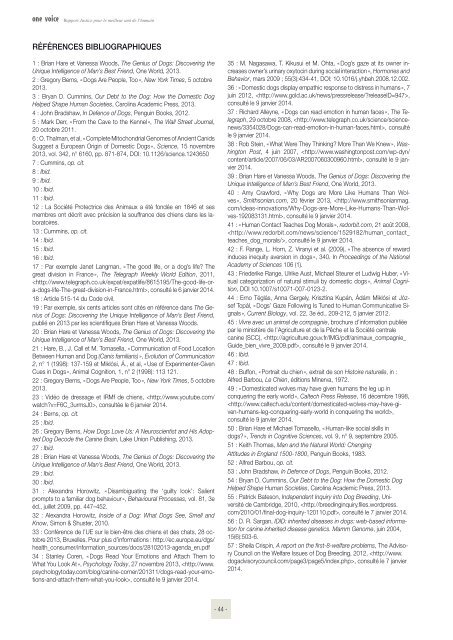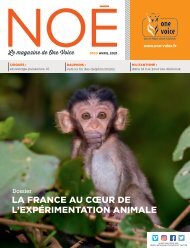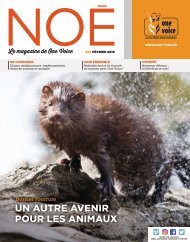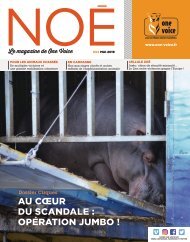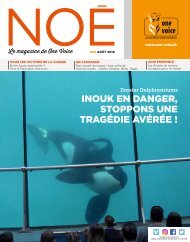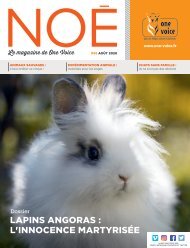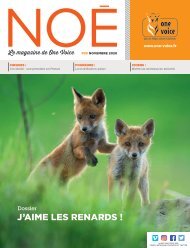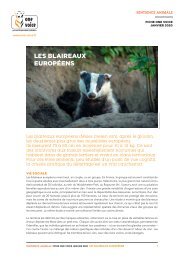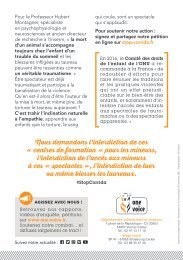You also want an ePaper? Increase the reach of your titles
YUMPU automatically turns print PDFs into web optimized ePapers that Google loves.
<strong>Rapport</strong> Justice pour le meilleur ami de l’humain<br />
RÉFÉRENCES BIBLIOGRAPHIQUES<br />
1 : Brian Hare et Vanessa Woods, The Genius of Dogs: Discovering the<br />
Unique Intelligence of Man’s Best Friend, One World, 2013.<br />
2 : Gregory Berns, « Dogs Are People, Too », New York Times, 5 octobre<br />
2013.<br />
3 : Bryan D. Cummins, Our Debt to the Dog: How the Domestic Dog<br />
Helped Shape Human Societies, Carolina Academic Press, 2013.<br />
4 : John Bradshaw, In Defence of Dogs, Penguin Books, 2012.<br />
5 : Mark Derr, « From the Cave to the Kennel », The Wall Street Journal,<br />
20 octobre 2011.<br />
6 : O. Thalman, et al, « Complete Mitochondrial Genomes of Ancient Canids<br />
Suggest a European Origin of Domestic Dogs », Science, 15 novembre<br />
2013, vol. 342, n° 6160, pp. 871-874, DOI: 10.1126/science.1243650<br />
7 : Cummins, op. cit.<br />
8 : Ibid.<br />
9 : Ibid.<br />
10 : Ibid.<br />
11 : Ibid.<br />
12 : La Société Protectrice des Animaux a été fondée en 1846 et ses<br />
membres ont décrit avec précision la souffrance des chiens dans les laboratoires.<br />
13 : Cummins, op. cit.<br />
14 : Ibid.<br />
15 : Ibid.<br />
16 : Ibid.<br />
17 : Par exemple Janet Langman, « The good life, or a dog’s life? The<br />
great division in France », The Telegraph Weekly World Edition, 2011,<br />
,<br />
consulté le 6 janvier 2014.<br />
18 : Article 515-14 du Code civil.<br />
19 : Par exemple, six cents articles sont cités en référence dans The Genius<br />
of Dogs: Discovering the Unique Intelligence of Man’s Best Friend,<br />
publié en 2013 par les scientifiques Brian Hare et Vanessa Woods.<br />
20 : Brian Hare et Vanessa Woods, The Genius of Dogs: Discovering the<br />
Unique Intelligence of Man’s Best Friend, One World, 2013.<br />
21 : Hare, B., J. Call et M. Tomasella, « Communication of Food Location<br />
Between Human and Dog (Canis familiaris) », Evolution of Communication<br />
2, n° 1 (1998): 137-159 et Miklósi, Á., et al, « Use of Experimenter-Given<br />
Cues in Dogs », Animal Cognition, 1, n° 2 (1998): 113 121.<br />
22 : Gregory Berns, « Dogs Are People, Too », New York Times, 5 octobre<br />
2013.<br />
23 : Vidéo de dressage et IRMf de chiens, , consultée le 6 janvier 2014.<br />
24 : Berns, op. cit.<br />
25 : Ibid.<br />
26 : Gregory Berns, How Dogs Love Us: A Neuroscientist and His Adopted<br />
Dog Decode the Canine Brain, Lake Union Publishing, 2013.<br />
27 : Ibid.<br />
28 : Brian Hare et Vanessa Woods, The Genius of Dogs: Discovering the<br />
Unique Intelligence of Man’s Best Friend, One World, 2013.<br />
29 : Ibid.<br />
30 : Ibid.<br />
31 : Alexandra Horowitz, « Disambiguating the ‘guilty look’: Salient<br />
prompts to a familiar dog behaviour », Behavioural Processes, vol. 81, 3e<br />
éd., juillet 2009, pp. 447–452.<br />
32 : Alexandra Horowitz, Inside of a Dog: What Dogs See, Smell and<br />
Know, Simon & Shuster, 2010.<br />
33 : Conférence de l’UE sur le bien-être des chiens et des chats, 28 octobre<br />
2013, Bruxelles. Pour plus d’informations : http://ec.europa.eu/dgs/<br />
health_consumer/information_sources/docs/28102013-agenda_en.pdf<br />
34 : Stanley Coren, « Dogs Read Your Emotions and Attach Them to<br />
What You Look At », Psychology Today, 27 novembre 2013, ,<br />
consulté le 9 janvier 2014.<br />
35 : M. Nagasawa, T. Kikusui et M. Ohta, « Dog’s gaze at its owner increases<br />
owner’s urinary oxytocin during social interaction », Hormones and<br />
Behavior, <strong>mars</strong> 2009 ; 55(3):434-41, DOI: 10.1016/j.yhbeh.2008.12.002.<br />
36 : « Domestic dogs display empathic response to distress in humans », 7<br />
juin 2012, ,<br />
consulté le 9 janvier 2014.<br />
37 : Richard Alleyne, « Dogs can read emotion in human faces », The Telegraph,<br />
29 octobre 2008, ,<br />
consulté<br />
le 9 janvier 2014.<br />
38 : Rob Stein, « What Were They Thinking? More Than We Knew », Washington<br />
Post, 4 juin 2007, , consulté le 9 janvier<br />
2014.<br />
39 : Brian Hare et Vanessa Woods, The Genius of Dogs: Discovering the<br />
Unique Intelligence of Man’s Best Friend, One World, 2013.<br />
40 : Amy Crawford, « Why Dogs are More Like Humans Than Wolves<br />
», Smithsonian.com, 20 février 2013, ,<br />
consulté le 9 janvier 2014.<br />
41 : « Human Contact Teaches Dog Morals », redorbit.com, 21 août 2008,<br />
, consulté le 9 janvier 2014.<br />
42 : F. Range, L. Horn, Z. Viranyi et al. (2009), « The absence of reward<br />
induces inequity aversion in dogs », 340. In Proceedings of the National<br />
Academy of Sciences 106 (1).<br />
43 : Friederike Range, Ulrike Aust, Michael Steurer et Ludwig Huber, « Visual<br />
categorization of natural stimuli by domestic dogs », Animal Cognition,<br />
DOI 10.1007/s10071-007-0123-2.<br />
44 : Erno Téglás, Anna Gergely, Krisztina Kupán, Ádám Miklósi et József<br />
Topál, « Dogs’ Gaze Following Is Tuned to Human Communicative Signals<br />
», Current Biology, vol. 22, 3e éd., 209-212, 5 janvier 2012.<br />
45 : Vivre avec un animal de compagnie, brochure d’information publiée<br />
par le ministère de l’Agriculture et de la Pêche et la Société centrale<br />
canine (SCC), , consulté le 9 janvier 2014.<br />
46 : Ibid.<br />
47 : Ibid.<br />
48 : Buffon, « Portrait du chien », extrait de son Histoire naturelle, in :<br />
Alfred Barbou, Le Chien, éditions Minerva, 1972.<br />
49 : « Domesticated wolves may have given humans the leg up in<br />
conquering the early world », Caltech Press Release, 16 décembre 1998,<br />
,<br />
consulté le 9 janvier 2014.<br />
50 : Brian Hare et Michael Tomasello, « Human-like social skills in<br />
dogs? », Trends in Cognitive Sciences, vol. 9, n° 9, septembre 2005.<br />
51 : Keith Thomas, Man and the Natural World: Changing<br />
Attitudes in England 1500-1800, Penguin Books, 1983.<br />
52 : Alfred Barbou, op. cit.<br />
53 : John Bradshaw, In Defence of Dogs, Penguin Books, 2012.<br />
54 : Bryan D. Cummins, Our Debt to the Dog: How the Domestic Dog<br />
Helped Shape Human Societies, Carolina Academic Press, 2013.<br />
55 : Patrick Bateson, Independent Inquiry into Dog Breeding, Université<br />
de Cambridge, 2010, , consulté le 7 janvier 2014.<br />
56 : D. R. Sargan, IDID: inherited diseases in dogs: web-based information<br />
for canine inherited disease genetics. Mamm Genome, juin 2004,<br />
15(6):503-6.<br />
57 : Sheila Crispin, A report on the first-8-welfare problems, The Advisory<br />
Council on the Welfare Issues of Dog Breeding, 2012, , consulté le 7 janvier<br />
2014.<br />
- 44 -


